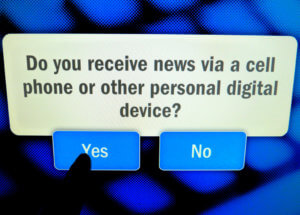Taking Connection in the Right Direction
Published on July 23, 2017, at 8:09 p.m.
by Jessica Banks.
If you are like me, your parents used to harp on you to put your cellphone down in your teenage years. It is even more relevant today as children are getting smartphones and other electronics at earlier ages. As a kid born in the 90s, I didn’t even know what a smartphone was. I was naturally more active in my free time because I did not have the exposure to the digital world that has indefinitely evolved.
 Today, individuals are in a form of relationship with their phone that has never existed before. Most of us keep our phones on our bedside tables when we sleep, making them the first thing we interact with when we wake up. We have the ability to be connected to the world at all hours of the day; something that has never been an option in previous years. We can text, call, tweet, DM and swipe left all in a matter of seconds, connecting us to people across the living room, or even across the world. We are in control of who and how we bond with other virtual companions.
Today, individuals are in a form of relationship with their phone that has never existed before. Most of us keep our phones on our bedside tables when we sleep, making them the first thing we interact with when we wake up. We have the ability to be connected to the world at all hours of the day; something that has never been an option in previous years. We can text, call, tweet, DM and swipe left all in a matter of seconds, connecting us to people across the living room, or even across the world. We are in control of who and how we bond with other virtual companions.
But has this online connection that has given us a newfound variation of control has manipulated us in a way?
As technology has improved and the smartphone has taken over cellular networks, it seems that the way kids wish to spend their free time has also changed. Children today are attracted to virtual play instead of outdoor activity. Their interest in the the latest app has dominated their desire to physically communicate with others. According to Pew Research Center, in 2008 a reported 71 percent of teenagers had a cell phone. This percentage is increasingly higher than the 45 percent of teens who had their own phone in 2004.
Even though this problem has affected teens and children more over the years, it cannot be pinned to one generation or age group. While our phones do provide immense distraction from our daily tasks, they are also a source of how we get our information.
Television is still the leading provider in terms of how people get their news, but online publications such as website and applications come in second place. Fifty-eight percent of Americans view their news from the TV and 37 percent choose to read through the screen.
Within these screens are apps, emails, websites and more through which people can collect information needed to stay up to date with certain topics. Knowing people have reached the relationship with their phone that some classify as an “addiction,” PR and advertising specialists have changed their business strategies to fit this trend. They have adapted to the latest application updates to appeal more to their customers. For example, Snapchat, a leading social media app, has introduced various new features within the past few months that changed it from being a picture-sending outlet to a multimedia platform.
The New York Times lists the several new additions including Snapchat memories, live stories, new filters and chat. The introduction of these new abilities could be partially credited to competitors such as Instagram debuting its version of stories. The competitions between news and entertainment apps is never ending, making it easier and easier for smartphone users to gain access to basically any information they want.
Regardless of the medium, the amount of information available and ease to get it have exponentially increased over time.
The updates from these media companies have revolutionized the way people access their information, on top of the constantly updating devices themselves. There is no limit on where or how you can get the news, explaining why it is so hard to put down our phones some of the time.
The key to solving this problem is balance. Even though we have the opportunity to be connected to the rest of the world at all hours to the day, it is important to rest our brains from the virtual world. Smartphones, applications and other electronics capture and distribute the visuals of a moment, but they will never capture the feeling of being present.





